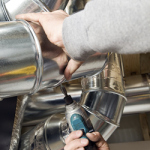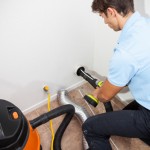 HVAC technology is constantly evolving to improve energy efficiency and support building health. An example of this is the development of wall caps and vents designed to protect a building’s rainscreen. And while rainscreen compatible vents are an innovation that’s here to stay, some equipment goes in and out of style. Induction HVAC falls in this category.
HVAC technology is constantly evolving to improve energy efficiency and support building health. An example of this is the development of wall caps and vents designed to protect a building’s rainscreen. And while rainscreen compatible vents are an innovation that’s here to stay, some equipment goes in and out of style. Induction HVAC falls in this category.
Induction air conditioners were a common choice for large buildings in the 1970s and 1980s. Popular because they were more efficient than the fan-based units available at the time, and because they required less ductwork, many of these units were well-maintained and operated for decades. But at 40+ years old, many of them are now in decline. Facility managers have to make the tough decision of whether to replace them with new induction units or to completely overhaul the building’s HVAC system.
What is induction HVAC?
An induction system is made up of a large central air handler that delivers primary air to smaller delivery or terminal units. The main feature that distinguishes induction units from other systems is the use of nozzles rather than fans in the terminal unit. Primary air is pushed through an array of nozzles creating a venturi effect or vacuum that draws secondary air from the room. The secondary air mixes with the primary air before being returned to the room. Temperature is regulated with coils, most often a water coil. Induction units can both heat and cool, but they operate most efficiently when used for cooling.
Why should you replace these systems? The terminal units can be noisy due to the velocity of air moving through them. Some buildings have had issues with the static air pressure, and some have had moisture issues. General deterioration also forces facility managers to explore alternatives.
Replacement options
The first option is to replace induction units with a different kind of system. Building operators can switch to a fan and coil system, but that would require installing new ductwork. If the induction units were part of the original building design, or if the building predates the widespread use of central HVAC, finding space for the extra ductwork is a challenge.
Another option is the ductless split system, which uses smaller units indoors and a large unit outdoors. This is similar in design and function to the induction system, which might appeal to occupants. These systems are also very energy efficient. The downside is that there is no air exchange with a split system, so ventilation needs to be taken into account.
The simple option is to replace the induction system with a new updated induction system. Many facility managers are taking this route. Fortunately, the technology has improved, and managers can see energy efficiency improvements of more than 30% with an upgrade. One argument in favor of staying with an induction system is that buildings can be upgraded one terminal unit at a time, which is a critical factor for high-use buildings like hospitals.
Today’s induction systems are far more energy efficient and quiet than those made in the 1970s, and there are more options to choose from. The two alternate induction systems are a Variable Air Volume (VAV) induction system which, as the name suggests, can deliver different volumes of air, which avoids dumping cold air into a room and the currently popular chilled beam system.
A chilled beam system is made up of a fin-and-tube heat exchanger that is typically suspended from the ceiling. There are two kinds of chilled beam systems, active and passive. An active chilled beam functions more like the induction systems of the decades past, as the beam delivers primary air from a central air handler.
Recently there’s a surge of interest in chilled beam and induction systems, which is in part due to the need to replace legacy induction systems. Regardless of which system your customer chooses, by upgrading their HVAC they will enjoy the benefits of the industry’s continual quest for improvement.



